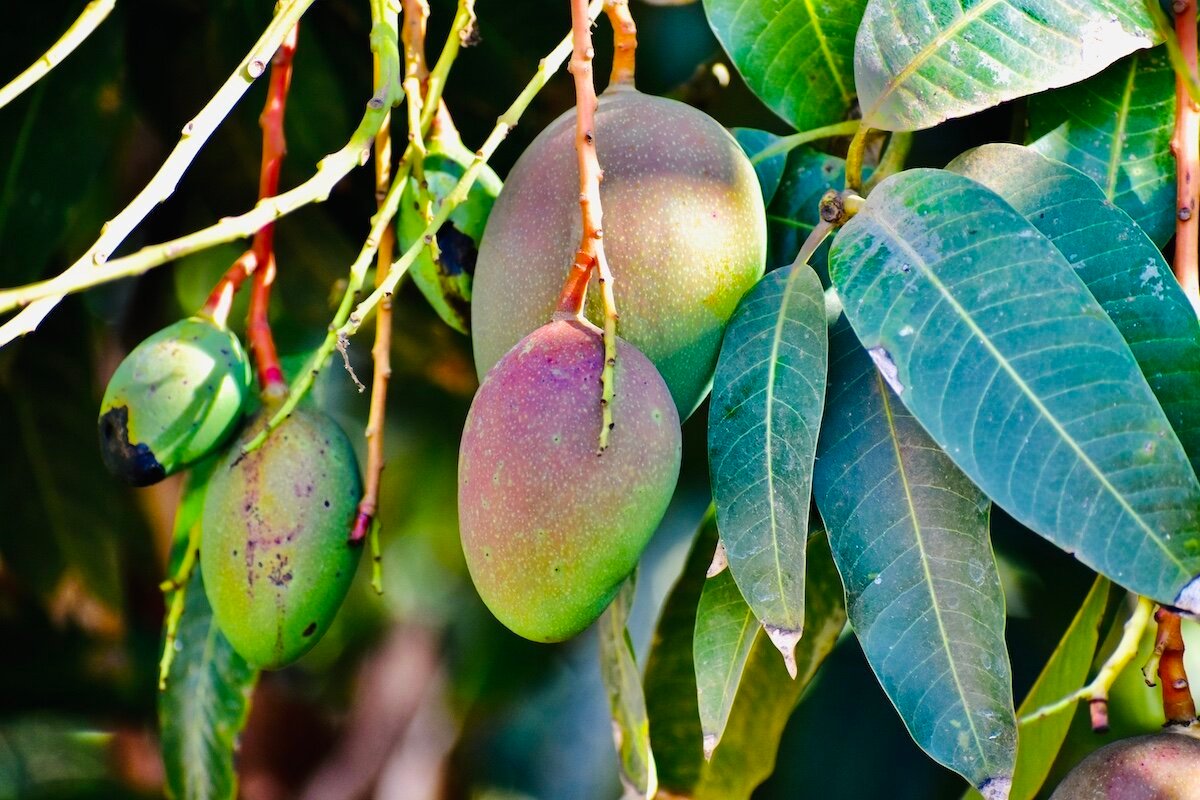WHAT ARE MANGOES?
Mangoes, or mangifera indica, come from the Anacardiaceae family, and can live to up to three hundred years. The tree produces a sweet tasting fruit that turns reddish/yellowish when ripe. Inside the mango is a large seed that is surrounded by orange edible flesh. Mangoes come in over 500 varieties. The amount of fruit that the tree produces depends on the variety. Some of the most common varieties of mangoes include the Alphonso, the Carabao, the Haden, the Kent, the Keitt mango, and the Palmer. On average, mangoes produce between 100 – 300 fruits per year, with some varieties producing a double crop in any given year.

WHERE DO MANGOES COME FROM?
The mango tree originated in India, which is located in the southern part of Asia. From there, the tree spread throughout the Asian content. In Asia, Thailand is the biggest producer of mangoes, followed by India and China. In Africa, mangoes are a popular produce item in Côte d’Ivoire, Egypt, and Ghana. Brazil and Peru are the top producers of mangoes in South America. In North America, Mexico leads in mango production.
WHO ARE THE BIGGEST EXPORTERS OF MANGOES?
Mexico is the biggest exporter of mangoes exporting $454.9 million dollars worth per year. The next biggest exporter is the Netherlands ($374.6 million), followed by Thailand ($275.1 million), Brazil ($205.5 million), and Peru ($191.7 million). Côte d’Ivoire is the largest exporter of mangoes on the African continent ($52.6 million), followed by Egypt and Ghana who make $49.8 million and $36.4 million dollars off of mango respectively.
WHO ARE THE BIGGEST IMPORTERS OF MANGOES?
The United States of America imports nearly a quarter of all mangos totally roughly $656 million dollars each year. The next largest importer is the Netherlands, followed by Germany, Vietnam, and the United Kingdom who import $280 million dollars, $197 million dollars, and $193 million dollars, and $190 million dollars worth of mangoes respectively. The demand for mangoes is high worldwide, commanding a premium price locally and in international markets. In America, mangos sell for any where between $1.50 (8.77 GHS) to $4.00 (23.4 GHS) per fruit.

HOW DO YOU GROW MANGOES?
Mangos grow well in tropical regions and thrive in almost any soil. Optimal growing conditions require well-drained soil that is not too moist. You can space the trees anywhere from 25 – 30 feet apart. The mango tree grows from the seed. You can plant the seed directly into the ground. On one acre, you can generally plant approximately 60 trees. According to Phillip Tetteh Paddi, a farmer in Kwayhia- Jato in the Eastern region of Ghana, one of the biggest challenges with growing mangoes are the insects/fruit flies that can ruin your entire crop. In order to avoid pests, you can spray in-between the trees with insecticide – an effective way to prevent loss of harvest.

HOW DO YOU HARVEST MANGOES?
The mango trees begins to fruit after approximately three years after planting. In the first few years, you may get as few as 20 mangoes per tree, however the yield from each tree drastically increases with each passing year. It is not uncommon for older mango trees (20 years +) to have anywhere from 500 to 3,000 fruits each harvest. Typically, buyers of the mango fruit will buy in bulk by the kilo. In Ghana, the price per kilo is between 1 – 2 GHS.

WHAT CAN YOU DO WITH MANGOES?
You can prepare mangoes in multiple different ways. They are a highly versatile food. As a food, mangoes provide great health benefits as they are high in antioxidants and are useful for boosting immunity. The mango fruit is also rich in iron and can help improve digestion. Mangoes are also a popular ingredient in pickles and chutneys. Mangos also produce a rich butter, that can be used in all-natural skin and beauty products. The butter from the mango can greatly improve the health of not only your skin, but your hair as well. The mango butter inside is difficult to process, but well worth it – a kilo of mango butter sells for $18 per kilo in the United States. Also consider the following high demand end products for your mangoes.
- Mango Juice
- Mango Oil/Butter
- Mango Jam
- Mango Chutney
- Frozen Mango Cubes
- Mango Ice Cream
- Mango Powder
HOW DO YOU GET STARTED IN THE MANGO FARMING BUSINESS?
To get started, select a good area to buy, rent, or hire. Use the seeds from local farmers in your region or partner with individual sellers of mangoes in the market to see if you can get their unused supply. Alternatively, you can also go to plant nurseries to get started. If you’re stuck or already in the business but would like to grow further, get in touch. We would be happy to help.
Love all-natural products made with mango? Check out our shop. We have mango butter and other products for the skin, body, and hair.














